I’ve put together an easy-to-play-with online model of methane in the atmosphere. I’m going to use it for teaching along with the rest of the Understanding the Forecast webmodels, but it was designed to be relevant to the issue of abrupt new methane burps as we’ve been ruminating about lately on Realclimate.
The model runs in three stages: a pre-anthropogenic steady state which ends in the model year
-50, addition of a new chronic source for 50 years (from human activity),then a spike beginning at model year 0 (supposed to be today) and running for 100 years into the model future. Here are results from the “worst case scenario” in the last post (whether you believe it is the true worst case or not): 200 Gton C over 100 years.
Looks like we got the factor of 10 methane increase about right.
Source and sink of methane in the model.
The lifetime of methane in the atmosphere, used to calculate the methane sink in any time step, is parameterized as a function of concentration following Schmidt and Shindell (2003).
The atmospheric lifetime of methane, used to calculate the sink flux.
The radiative forcing is parameterized from output from the NCAR model, scaled by an efficacy factor of 1.4 from Hansen et al, (2005). The radiative forcing is compared with Business-as-usual CO2 radiative forcing with the model year 0 corresponding roughly to year 2010, and with CO2 rising at 0.65% per year. The methane radiative forcing before year 0 is not time-realistic because the real human sources did not switch on instantaneously 50 years ago, but you can compare the future evolution of radiative forcing from CO2 and methane, from year 0 onwards.
The radiative forcings of CO2 and methane compared. The scenario is more-or-less comparable to 750 ppm CO2, as we thought.
The CO2 concentration used to generate the last figure.
Timing is everything
Four simulations with the same amount of carbon released as methane in the “spike”, on different time scales for the release.
10 Gton C release in 1 year — the spike.
Same spike but not as sharp: 10 Gton over 20 years.
Same 10 Gton but spread over 50 years.
Enjoy. Go and get your swamp gas on, and give the poor model planet your worst. Bwahahahahaha!
References
- G.A. Schmidt, and D.T. Shindell, "Atmospheric composition, radiative forcing, and climate change as a consequence of a massive methane release from gas hydrates", Paleoceanography, vol. 18, 2003. http://dx.doi.org/10.1029/2002PA000757
- J. Hansen, M. Sato, R. Ruedy, L. Nazarenko, A. Lacis, G.A. Schmidt, G. Russell, I. Aleinov, M. Bauer, S. Bauer, N. Bell, B. Cairns, V. Canuto, M. Chandler, Y. Cheng, A. Del Genio, G. Faluvegi, E. Fleming, A. Friend, T. Hall, C. Jackman, M. Kelley, N. Kiang, D. Koch, J. Lean, J. Lerner, K. Lo, S. Menon, R. Miller, P. Minnis, T. Novakov, V. Oinas, J. Perlwitz, J. Perlwitz, D. Rind, A. Romanou, D. Shindell, P. Stone, S. Sun, N. Tausnev, D. Thresher, B. Wielicki, T. Wong, M. Yao, and S. Zhang, "Efficacy of climate forcings", Journal of Geophysical Research: Atmospheres, vol. 110, 2005. http://dx.doi.org/10.1029/2005JD005776
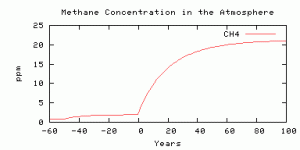
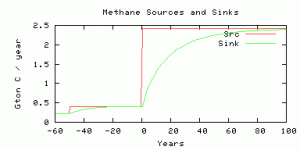
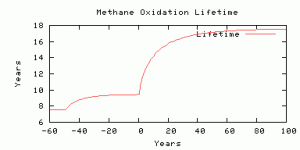
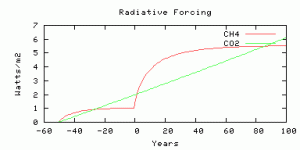
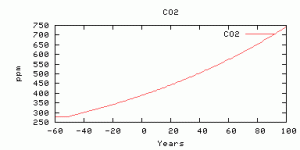
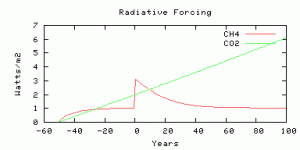
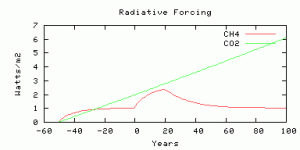
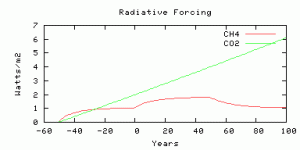
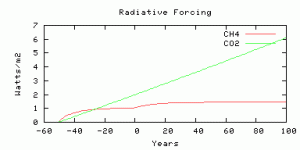
ruminate and methane – are the cows having the last laugh here I wonder?
Thanks for the interactive model, but the assumption implicit in it is that there will be a one time spike or a steady quantity over some period of time.
Isn’t it much more likely that feedback will increase the amount of methane released every year for however long it takes to melt all the clathrate and release all the free methane below? Is there some way to model such a result?
Or are you assuming that any release will come all at once since, as the NASA report put it, there is a zipper-like chain reaction–once hydrates start dissolving in one place, sea water rushes down filling in the now empty space and in turn destabilizing neighboring hydrates…?
[Response:By setting the duration of a slug (“spike”) to 100 years, say, there will be a new source imposed every year for 100 years. Kinda loses its spikiness. David]
Very nice! I think I broke it. Try using the following parameters:
Chronic methane flux: 0.2
Methane spike size: 5
Methane spike duration: 0.50000000001
and then:
Chronic methane flux: 0.2
Methane spike size: 5
Methane spike duration: 0.50
[Response:It’s got a 1-year time step. (“Doctor, doctor, it hurts when I do this!” “Don’t do that”). David]
Re #2. I put in a 500 Gton “burp” over a 10 year period, and it overwhelmed C02 for the first 50 years, then CO2 dominated from thereon. I know it doesn’t model any feedback loops caused by the methane, but even a very large methane burp doesn’t seem to have the long-term effect of CO2, which we already knew eh?
Cue panicked response of “But the models are wrong!!!” in 5, 4, 3,…
The model does not convert decaying methane to CO2. This is not very realistic.
[Response:But the CO2 effect from that carbon is small compared with the methane effect. You’re seeing most of the response, just from the methane. Compare 200 Gton C from my “worst case scenario” with maybe 1600 Gton C from fossil fuels by the end of the century under business-as-usual. David]
Is there significant spatial variation in the atmospheric methane sink?
[Response: Yes, it’s dominated by the tropical troposphere. – gavin]
Question: won’t melting permafrost and bubbling clathrates continue to put CO2 into the atmosphere even if humans stop? If so won’t the climate now warm regardless of what we do?
[Response:No, there’s a lot more warming in the pike from our projected future CO2 emissions than we’ve provoked so far. So far is only the tip of the iceberg. David]
The most likely trajectory of increasing methane release from land and sea Arctic sources is exponential, so it is not clear that this graphing program is very useful in modeling this most likely development.
We can’t know exactly how any of this will go down, of course.
“The magnitude and feedbacks of future methane release from the Arctic region are unknown…
if global methane emissions were to increase by factors of 2.5 and 5.2 above current emissions, the indirect contributions to RF would be about 250% and 400%, respectively, of the RF that can be attributed to directly emitted methane alone.
Assuming several hypothetical scenarios of CH4 release associated with permafrost thaw, shallow marine hydrate degassing, and submarine landslides, we find a strong positive feedback on RF through atmospheric chemistry. In particular, the impact of CH4 is enhanced through increase of its lifetime, and of atmospheric abundances of ozone, stratospheric water vapor, and CO2 as a
result of atmospheric chemical processes. Despite uncertainties in emission scenarios, our results provide a better understanding of the feedbacks in the atmospheric chemistry that would amplify climate warming.”
http://www.agu.org/pubs/crossref/2011/2010GB003845.shtml
Are depletion of hydroxyl, ozone…included in the above model?
(reCaptcha: (Kyd) helphme
[Response:Yes, depletion of OH is what allows the lifetime to go up with methane load. The indirect radiative effects are accounted for with Hansen’s factor of 1.4 efficacy. David]
Wili,
Huh? Why would you assume an exponential profile? That makes no sense unless we are in a metastable state–e.g. like a supersaturated solution.
Thanks for this. I’ve been using your Understanding the Forecast book to teach climate change for a couple of years, and the interactive models are a fantastic pedagogical resource.
However, both with the GEOCARB model and your nice new methane model, sometimes the tiny graphs are not the ideal output. Would it be sufficiently easy for you to provide an option to download the text output from the model runs, the way one can for MODTRAN, NCAR radiation codes, and orbital forcing?
[Response:Sure, I’ll get it set up. David]
Lovelock’s predicts that after an initial phase (from amplifying feedbacks) the climate system makes one big jump/spike and the climate stabilzes at a new hotter climate state. http://www.youtube.com/watch?v=MN8x9A0S_sM
How much consideration have been done to account for Lovelock’s model input? Could this climate state switch function, like a memristive function (for non-linear properties) be modeled too?
[Response:Well, one can make a computer program do whatever you program it to do, but it’s more useful to build up a model from component pieces that you think you understand, and see if “emergent behavior” emerges, like sudden climate flips. I’m not sure exactly what mechanisms Lovelock in particular has in mind. I know of models of methane in an anoxic atmosphere, CO2 clouds in a very high-CO2 atmosphere, the snowball Earth glaciations, runaway greenhouse effects, all of these are ideas of specific tipping points which have been modeled. David]
I’m off to a meeting tomorrow in the UK Parliament. It a meeting about a report for cutting the carbon emissions for the City of Leeds,The economics of low carbon cities. They say
I don’t quite believe them (“40% at no net cost”) – I think that the reduction is much too small but if the world can withstand 750ppm CO2e as mentioned above am I being unreasonable in criticising them for
Me? I would say redesign our lives to avoid Hansonian dangers and tell the people of Leeds not to fly, not to eat beef or lamb, not to build using concrete and steel and not to rely on economic growth to get us out of this difficulty and find another way of creating jobs. Is this unreasonable?
OK, this might seem off topic but I think we have to be more specific as to how we reconcile our lifestyles with the dangers of climate change. Even if the chances of the methane gun are as little as David suggests, it is an interesting thought experiment.
P.S. My local council’s public wifi won’t let me access sites that mention the clathrate gun. It’s classed as a persoinal weapon.
P.P.S. Sorry the link above is to a summary only. I expect you would all like to see a few hundred examples on a Marginal Abatement Curve.
Though the video i linked was not very infromative regards his to specifications. I found now better information and learned he was referring to his Daisyworld model.
Because Daisyworld is so simplistic, having for example, no atmosphere, no animals, only one species of plant life, and only the most basic population growth and death models, it should not be directly compared to Earth. This was stated very clearly by the original authors. Even so, it provided a number of useful predictions of how Earth’s biosphere may respond to, for example, human interference. Later adaptations of Daisyworld (discussed below), which added many layers of complexity, still showed the same basic trends of the original model. http://en.wikipedia.org/wiki/Daisyworld
[Response:Daisyworld is a fairy tale, no more really. A parable. Plants do not control Earth’s climate by altering the albedo. Not even daisies. David]
#9 Wili,
As stated in the text of the main article the model uses the results of Schmidt & Shindell 2003. That paper uses a chemical model that factors in NO2, O3, and OH to calculate the extension of atmospheric lifetime due to reduced opportunity for reaction of CH4.
I have to agree with Ray Ladbury – you have no scientific grounds for assuming a steady exponential increase of CH4. i.e. here’s the opportunity for you or anyone else to state the mechanism. Hand waving allegories about ice sheet melt will not suffice – sea sediment beds are not ice sheets in a very fundamental physical sense.
A plea if anyone knows the GISS website graphics folks,
after looking at the methane article there:
Pie chart full in the face — not good, but not wholly awful.
Pie chart viewed tipped almost horizontally — bad.
Example: http://icp.giss.nasa.gov/education/methane/intro/methanesources.gif
“poor representation of the magnitude …. more difficult for the eye to discern the relative size of pie slices than … bar length.” http://lilt.ilstu.edu/gmklass/pos138/datadisplay/sections/goodcharts.htm
I think there are a lot of missing pieces here. If we don’t accept a strong feedback effect that increases methane emissions exponentially, we are intentionally ignoring factors that we know exist. When the methane is emitted from permafrost, it adds to the forcing and there is that much more carbon sitting in the permafrost that is thereby thawed. I think Isaksen et al are going in the right direction, but fall short of the mark due to conservative numbers that don’t consider the reality of methane’s capability during its lifetime in the atmosphere. And few if any models are using the real strength of methane when it is first emitted (100 times CO2) and slowly decreases to reach 72 at 20 years. If that were all there is to achieve a feedback effect it would already be huge. But that’s not all.
As wili points out, the clathrates are there to affect greater feedback. We have less understanding of the clathrate burden in the Arctic than that of the permafrost carbon, but we know that the potential for methane emissions from the sea bed is serious.
Then we have the dual effect of the added methane having the added RF on the Arctic sea water, which is now more available to that forcing due to the loss of sea ice, with the increased thermal energy of the Arctic waters in turn moving over the permafrost to increase thawing. I haven’t seen this dual effect described in any articles.
However, the atmospheric chemistry situation gets a little fuzzy when we identify a feedback effect of increased ozone coming from the increase in methane. While methane as a VOC is a precursor to ozone, and ozone is a GHG, ozone is a precursor to OH which removes methane. So increased methane adds to the ozone burden but then gets removed to some extent by the extra OH from the extra ozone. I haven’t seen any good discussions of that full combination. Please provide any references that you have on this.
Then we can’t ignore Hansen’s position that black carbon needs to be given greater consideration for its effect on Arctic albedo. The warming from the impact of black carbon causes more deforestation which is tied to increased wildfires that result in more black carbon.
I can see a Lovelock scenario but his presentation does not provide an understanding of how this dramatic jump can happen. I think if all of the feedback effects identified above acting on each other are fully incorporated in a well-reasoned model, we would see how they could cascade into an abrupt climate change.
I think it is extremely important that we communicate to the public a range of possibilities including worst case and some general ideas of probability. The saying “Prepare for the worst and hope for the best,” should be a mottoB. But we are not yet there on what really is the worst. Of course we have the political reality of the deniers denying even the mildest climate change forecast and this would add to their claims that we are “alarmists.” But we aren’t doing our job if we don’t try to communicate how bad it could be and why that worst case forecast has a strong science foundation. But we need to present a strong case and so far we are not quite there.
Very nice to see something that calculates and displays.
But it cries out for improvement — needs better usability display. Make a bigger display, layout the data labels better.. please?
You say, “Well, one can make a computer program do whatever you program it to do,” – so could you elaborate a little on your methane model? Did it simply use
a GWP to translate the CH4 forcing to CO2? If yes, what was the figure you used? If not, how does it work, how does it account for indirect effects, etc? – and if it is all very complicated, could you please translate it all roughly into a 100yr GWP for us?
[Response:Ugh, global warming potentials make me itch. No, it’s direct, instantaneous radiative forcing in Watts/m2. Tell you what, I’ll post the fortran code here. David]
Alan D. Roth says #17 “I can see a Lovelock scenario but his presentation does not provide an understanding of how this dramatic jump can happen.”
The 4th video fromt his link, explains in more detail the model (reasonable). Though it is tied to the Gaia Hypothesis he created while working for NASA on the early space programme to assess mars life carrying capabilities. Earth (Gaia) is aiming for an equilibrium state and certain thresholds interact with each other. The model is a very simplistic form of our biosphere/atmosphere. http://climateforce.net/2012/01/11/bbc-james-lovelock-interview-2011/
To Ray and Chris: Basically what Alan said.
It is my understanding that the basic mathematics of feedback is that it leads to exponential rates of growth for some period of time until a new equilibrium is reached (given a large enough source, which is what we seem to have in Arctic terrestrial and marine carbon stores.)
I didn’t think I had to source such a basic concept to this audience, but here’s one more-or-less-randomly-chosen source:
“Positive feedback loops act to magnify the impact of changes from outside the loop, and they often represent how the system is able to grow in exponential fashion.”
http://books.google.com/books?id=38PJahZTzC0C&pg=PA112&lpg=PA112&dq=positive+feedback+loop+exponential&source=bl&ots=xCiKowMAUE&sig=3Jg63flm2RMOIvoy4Sht6byupLQ&hl=en&sa=X&ei=eTwOT56DNtH3ggewuYnBBw&ved=0CGsQ6AEwDTgK#v=onepage&q=positive%20feedback%20loop%20exponential&f=false
If warming is causing methane release from terrestrial permafrost and seabed methane hydrates, then the more of this GHG they release, the more warming will be available to release more methane…
This is why I, at least, have been hanging on the rather ambiguous wording of a recent interview with Shakhova where she implies that the recent increase in methane release in the Arctic was not cause by GW. In that case, perhaps it is a self limiting, perhaps one-time burst that we can hope will not start an inevitable cycle of warming-release-warming…
But the mechanism we “alarmists” are alarmed about is the possibility of this kind of exponential growth. That’s why the exact amount of current emissions of Arctic methane (referred to dismissively here as ‘small potatoes’) is something of a red herring, since anyone with a chess board and stories about kings and rice jumbling around in their heads knows that very large things can come from very small origins.
http://www.singularitysymposium.com/exponential-growth.html
What we need to know is whether the emissions, whatever their current level, have launched into a feedback loop that will lead to exponential growth over a considerable period.
For the record, whatever the results, as far as I’m concerned, the message to the world community should be that we need to vastly reduce our own carbon emissions. But if we have set off a re-enforcing feedback loop (or an interacting set of them), we need to know that we must reduce emissions (and eventually sequester atmospheric carbon) at an exponential rate just to keep ahead of these mechanisms. I, for one again, would be greatly comforted if this were not the case, but only if it really is not the case–I am not interested in comforting but ill founded bromides.
I, like Geoffrey, am tasked with advising a major metropolitan area which is instituting a program to reduce GHG’s. I would like to give decision makers the best, most accurate information of where we actually are, no matter how dire the facts. I would appreciate courteous, clear advise and relevant, accurate information rather than curt dismissal of real concern.
Thank you,
wili/John U. Harkness
[Response:Feedbacks can lead to exponential growth, such as compound interest is really your bank balance feeding back to your bank balance, or population growth. But feedbacks can also be limited, such as the water vapor feedback on global climate, might have an exponential phase if one were starting from a dry atmosphere, say, but which will stop when the atmosphere reaches saturation with liquid or frozen water. For methane degassing in the Arctic to grow exponentially, you’d want the degassing rate to depend on itself, like empty channels somehow enable more methane to flow, or you’d want the climate to respond strongly to the methane, and the degassing to respond strongly and quickly to climate. I’d envision a methane degassing feedback to be a rise in the chronic flux, like we’ve already seen, in response to temperature and hydrology, rather than an exponential explosion. David]
I would also like to add to Alan’s “prepare for the worst, hope for the best” the saying of the philosopher Antonio Gramsci “pessimism of the intellect, optimism of the will.”
[Response:I like that.–Jim]
> what really is the worst
Physicists should recall, when constructing worst cases, that to biologists we’re well into a great extinction event, and those generally haven’t ended well for charismatic megafauna, among which this time we are included.
Worst case? Lee Kump outlined it in 2005; Peter Ward wrote a book on it.
Can we rule it out? Admittedly we have no evidence it’s happening and haven’t got a model that lets it happen in the computer.
See this is the scary-movie-story line, and it’s — science:
http://www.annualreviews.org/doi/pdf/10.1146/annurev-earth-042711-105329
End-Permian Mass Extinction in the Oceans: An Ancient Analog for the Twenty-First Century?
JL Payne… – Annu. Rev. Earth Planet. Sci, 2012 – annualreviews.org
“… Sulfur isotope record based on data… suggest development of anoxia”
Just as microorganisms have been able to do wonders when challenged by antibiotics, in just a few decades. I do wonder what they’ll find selectively advantageous (for some of them) about climate change. They seem to have managed the previous great extinction events rather well for themselves.
It’d be ironic if the gray goo taking over the world came not from the labs of the nanotechies but from good old natural-born slime, evolving under the time pressure unique to this current extinction event.
Who was it pointed out we’re not doing any better than the blue-green algae yet? Well, we’re faster, at least out of the gate. But they could catch up.
Not _too_ likely, probably.
We no longer have large stores of agricultural commodities in storage. A methane burp can disrupt civilization by changing the weather enough to disrupt agricultural production for a very few years.
It does not matter if it is a one-year burp or a 10-year burp, if it changes weather more than our primary agricultural crops can tolerate, then it is a real problem, regardless of how fast it is converted into CO2.
The model does not give a hint of how a change in the concentration of methane (or CO2) will affect agriculture. Burps of methane in deep water will change the chemistry and ecology of the ocean, thereby affecting fishing (and our food supply).
Less than 400 ppm of CO2 results in weather that is affecting food prices, and yet folks here are blithely discussing large amounts of additional greenhouse gases in the system without a word of what it will do to the food supply.
# 10 Ray,
We have a dynamic, non-linear feedback system (weather) with lags between input and feedback. For example, CO2 emissions were relatively linear, but retreat of Arctic sea ice both lags emissions and is not linear. My example would be the movement of a fire through a house. It may take hours to get from spark to small flame, but it might go from a small flame to “flashover” and loss of the structure in minutes.
# 15 Chris,
Melting ice/freezing water is a local equilibrium reaction that depends on local energy. Water/ice are subject to the same physics when they are at the top of an ice sheet or at the bottom of an ocean or in a laboratory.
[Response:I agree that a climate change need not be eternal to be horrifying. Droughts of more than a few years have an enormous impact on agriculture. I find this the more frightening part of the climate change forcast, personally. David]
Willi: You are conflating mathematics with the physical world. While you are correct that in mathematics exponential growth is frequently the result of instability and feedback, this need not be the case in reality. An example which is not entirely off-point is the relationship between atmospherics CO2 and temperature. A doubling of CO2 is expected to result in roughly a 3C increase in mean temperature. A second doubling of CO2 is expected to result in another 3C increase in mean temperature. This is a logarithmic increase which is far slower than the exponential increase you would posit.
Strangely, I couldn’t find any parameters that gave a result equivalent to a comforting hug. Playing with figures is sometimes a good recipe for sleepless nights.
24 Aaron Lewis: Roger that. How is the winter wheat doing? It needs snow and there isn’t any yet. Does anybody know?
@David
Thought your video lectures for non science majors, in the links, were excellent! Relaxed, engaging and informative presentation.
Looks like you do a good course, impressed!
I am not convinced about exponential growth. I consider vague talking about positive feedback loops as distinctly unenlightening – positive feedbacks can also lead to oscillation, not exponential growth. What counts is the system within which the feedback operates. Oscillation? e.g. Warming of sea bottom sediments leads to eruptions at small local areas which then destabilise surrounding areas, so they erupt, until a large area has erupted forming a ‘pock mark’ which is still visible in sonar observations millenia later. But the point is that these eruptions are self-limiting – they do stop at a point forming crater like formations. So instead of an exponential rise you get a series of ‘blips’.
By far the largest factor in Arctic amplification at present is the loss of sea-ice and the warming that the resultant open ocean then causes to the atmosphere (Screen & Simmonds 2010). I am not aware of evidence of CH4 is playing a role at present, if you are feel free to tell me. Granted the inevitable further warming of the Arctic will cause further degradation of permafrost and CH4 emissions from boreal wetlands, both likely having a strong role in the recent uptick in atmospheric concentration of CH4 (Fisher 2011, Dlugokencky 2009). The CH4 signature of melting permafrost seems to be evident in AIRS CH4 retrievals (Yurganov 2011), but emissions from the East Siberian Shelf don’t appear to be leaving a strong signature. However at present handwaving about ‘feedback’ faces a chicken-and-egg hurdle, because most of the current Arctic warming is not due to CH4, emissions of CH4 will have to increase massively to invoke such a feedback, and all this is happening against a background of substantial ongoing forcing increases are from CO2. Dr Archer’s simple model shows that even with a 100 fold increase in Arctic CH4 emissions the result matches human emissions. I find this disturbing, but are we really going to see a 100 fold increase within the next couple of decades? If not then that gives CO2 even more of a head start.
Pace is crucial. As discussed at Skeptical Science:
http://www.skepticalscience.com/co2-rising-ten-times-faster-than-petm-extinction.html
CO2 is rising faster than the PETM. However, assuming that CH4 releases caused the second wave of the PETM (it’s my working assumption), this does not by extension mean that this secondary response of methane release will be equally as fast. It could initiate sooner, I suspect that we’re seeing the first beginnings of that, but the rapidity of warming does not mean we can then neglect the relatively slow process of that warming proceeding down the sediment column beneath the ocean. The PETM CH4 release probably took a millenium or so, at least, I get the impression from some of the comments here that people expect a release like the cork out of a champagne bottle – I see scant evidence for such an interpretation. Instead I see what Archer/Buffett/Brovkin describe as “a slow tipping point in the global carbon cycle”, slow in human terms even if rapid in geological terms.
In his previous post Dr Archer has shown how even a massive 100 times increase in CH4 emissions creates a significant and troubling impact, but not a catastrophe. To that many posters here have waved their hands around and claimed that’s too small, with what I consider loose reasoning. Now Dr Archer has provided a simple model and we have some insinuations that it’s too conservative. These are exact mirror of the sort of responses I expect to see from denialists, to see this here is very disappointing.
As for the extinction of humanity, humans have lived for many millenia on every continent but Antarctica without the benefit of advanced technology.
Aaron Lewis,
But the sediments at the bottom of the ocean don’t have moulins and basal lubrication / loss of terminal ice shelves, leading to increased flow of outlet glaciers. There’s a big difference between the commonality of physics at the microscopic scale and resultant processes at the macroscopic scale.
Dlugokecky, 2009, Observational constraints on recent increases in the atmospheric CH4 burden.
Fisher, 2011, Arctic methane sources: Isotopic evidence for atmospheric inputs.
Screen & Simmonds, 2010, The central role of diminishing sea ice in recent Arctic temperature amplification.
Yurganov, 2011, Presentation for Octobe 2011 London symposium on Arctic CH4.
Aaron Lewis: “My example would be the movement of a fire through a house.”
Well, except we don’t see anything remotely like this in the paleoclimate. Perhaps a better analogous system would be the limnic eruptions in volcanic lakes in Cameroun.
http://en.wikipedia.org/wiki/Limnic_eruption
Alan and Wili,
NO. Positive feedback need not result in instability or exponential growth. You are using the same argument denialists use to try and deny CO2 contributes to warming!
Some infinite series converge. Crack open your old calculus text and review.
@David and Gavin’s response to my #7. If the methane sink is dominated by the tropical troposphere (due to OH associated with very high water vapor concentrations and temps?) then will arctic methane emissions persist longer as methane than “average world methane” emissions? IE have a higher GWP? Does this matter quantitatively and is it reflected in the computer model? just curious
[Response:The atmosphere mixes on a time frame of a year (between hemispheres) or less (within hemispheres). Since the methane concentration is rising on a time frame which is long compared to this mixing, the concentration of the whole atmosphere changes together, which the model approximates by just having a single number representing the average atmospheric concentration. David]
> Plants do not control Earth’s climate by altering the albedo.
> Not even daisies. David]
Baaah! https://www.google.com/search?q=site%3Arealclimate.org+albedo+sheep
There have been several questions regarding the details of the model now. I thought I would test my understanding of it as I thought the explanation was pretty clear in the first place. This won’t help mathaphobes. I trust David will correct me if I say anything too egregious. Let M = [CH_4] = globally averaged concentration of methane. This is assumed to occur instantaneously. The model has no spatial variation. The model solves a single differential equation for the time rate of change of M:
dM/dt = sources – sinks
sources = chronic source + spike
Chronic source =
00.188 for t before -50 years.[Response:Natural emissions from wetlands mostly. The number comes from Schmidt and Shindell. Then at T = -50 years and for the rest of the simulation, you get natural + chronic human emissions, like the real world today. David]
Spike = M_S/duration * impulse
where M_S is the concentration associated with the amount of methane released:
M_s = Amount of methane released/Volume of atmosphere
impulse is a step function that is 0 for negative time and t> duration and 1 for
0<t<duration. That is the spike turns on at time t= zero and off at time t=duration.
sinks is the instantaneous concentration of methane divided by the lifetime of methane, tau_M:
sinks = M/tau_M
tau_M = a function(M
,CO2, …) documented in Schmidt & Shindle 2003.[Response:In the Schmidt paper they tabulated the lifetime as a function of the methane concentration only. This was for an oxic atmosphere, so presumably one could extend the parameterization to include O2, and probably other stuff like CO concentration etc. But in the on-line model it’s only a function of methane concentration. David]
One can learn something about tau_M by playing with the model. For small M tau_M = 7 1/2 years.
For large M it increases tau_M ~ sqrt(M)
As far as I can tell the CH4 doesn't decay into CO2 in this model. The plot of CO2 does not change when the model parameters change?
[Response:You’re right. I do have a CO2-only model here but it’s primarily intended for long time scales, doesn’t do the short-term transient as well as more complex carbon cycle models (Archer et al., Ann. Rev. 37:117–34, doi 10.1146/annurev.earth.031208.100206). The trick with simply adding the methane decomposition to the CO2 is accounting for how much goes into the ocean etc. Ray has asked for this, too, it’s a good idea and I’ll get to it. The bottom line I got is that the radiative impact of the accumulating CO2 from the decomposing methane was similar to the RF of the elevated methane concentration (Archer and Buffett, Geophys., Geochem., Geosystems. 6(3) doi:10.1029/2004GC000854). But you’re right, it’s neglected in this model. David]
The radiative forcing due to CH4 is calculated to an NCAR model. It wasn't clear to me whether that model includes water vapor feedback or not.
[Response:Water vapor feedback (warming leads to more water vapor leads to more warming) is considered a part of the climate response, not part of the radiative forcing, by definition. The source of water in the stratosphere from the hydrogens that methane carries is part of the “efficacy” of the methane forcing, a factor of 1.4 from Hansen, which is included in the on-line model. David]
David says:
But plant albedo has been under discussion
I attend the Parliamentary event (see #13), and though the report’s authors were at the beginning of a process, had some way to go, but were at least thoughtful and not dogmatic – I was pleasantly surprised. But time will tell as their project develops.
Others there may have stuck too closely to the UK Government line. e.g. The UK has cut emissions substantially since 1990. But I believe this ignores the embodied carbon in imports and the windfall brought about by using the UK’s reserves of natural gas in new powerstations.
[Response:Sure plants affect climate, but they are not the primary driver as in Daisyworld. David]
Thanks for all the comments. Without accusing my interlocutors of ‘hand waving’ nor comparing them to denialists, I would just like to point out that I did not say that feed back HAD to result in exponential growth, only that is one likely outcome, and that it would be nice to see that incorporated into such a model. Ultimately, many feedbacks would need to be taken into consideration. Presumably it was failure to appreciate the power of some such feedbacks that lead to the stunning failure of researchers to accurately predict the remarkable speed of sea ice loss in the Arctic.
I understand that modeling multiple feedbacks, positive and negative, can get messy, but that is what we are likely to face as the global industrial society continues to churn out GHGs at ever higher rates.
Besides the obvious negative feedback that it takes twice the CO2 to produce a set amount of warming, we have slow processes like weathering of mountains, organic material falling into deep ocean bottoms, deep rooted plants creating soil and a few others. But there are many other real and potential positive feedbacks, many of which may work much more quickly than these beyond permafrost melt and dissolving of seabed hydrates:
Other soil types drying out and releasing their carbon
Ocean waters warming and acidifying enough that they stop absorbing and start emitting carbon
Forests, grasses, peat, tundra…drying up and catching fire
And of course the faster ‘Charney’ feedbacks of albedo and water vapor
All of these and others feeding back on each other are what is likely to at some point drive us rather rapidly (but not in the Hollywood “Day After Tomorrow” sense) to some new much hotter equilibrium if we keep pushing more anthropogenic carbon forcing into the system. The whole world should be hopping nervous and alarmed that we are pushing hard on a system that we don’t fully understand and that could respond in ways we can’t fully anticipate. Instead, serious discussion of this situation seems to be restricted to this and a couple other sites, where serious concern seems to be met with ridicule.
I hope a carbon feedback doesn’t happen at all.
I hope that to the extent it does we get our collective… wits together immediately to bring down carbon emissions faster than any methane and CO2 that may start erupting from permafrost and seabed at ever growing rates.
I hope we can replant enough grassland and forest to draw down some of the carbon we have foolishly spewed into the atmosphere.
In fact, I have done more than hoped–I have worked on all of these goals an others for years.
But I also hope that this can be a place where concerned citizens can ask reasonable questions without being dismissed as ‘hand wavers’ or be compared to denialists.
Re plant albedo..
Apart from changes in the C cycle, changes in ecosystem energy balance can directly affect regional climate, and in the case of permafrost thaw may be inextricably linked with the C cycle changes already discussed. Changes in albedo brought about by changes in plant species composition, length of the snow season, lake area, or fire frequency can have positive or negative effects on climate warming. Increases in shrub cover in graminoid-dominated tundra ecosystems result in greater absorption of solar radiation in summer and winter, leading to local warming in the summertime (Chapin et al. 2005).
Similar patterns can be expected as the treeline moves north. Changes in ecosystem albedo can also have a cooling effect. Increased fire frequency in boreal forests alters the proportion of forest dominated by broadleaf deciduous trees. These early-successional species reflect more solar radiation in summer than do the needle-leaved evergreen species they replace, and expose high-albedo snow on the ground in winter.
These long-term albedo effects can offset increased warming from both the transfer of C to the atmosphere from fire and the short-term decrease in albedo immediately following fire, and may actually cool the climate (Randerson et al. 2006). Lake or wetland expansion may serve to regionally warm or cool the climate, depending on the type of vegetation replaced. http://www.aibs.org/bioscience-press-releases/resources/Schuur.pdf
Pro. Archer has kindly shared the code.May I ask if replacing the line
CH4_src = CH4_src + source_spike
by
CH4_src = CH4_src + A*exp(b/tau)
where the second term on the right represents
an exponentially rising source would satisfy
some of the commenters ?
sidd
[Response:Well, CO2 emissions, and concentrations in the atmosphere, are growing exponentially, as flux(t) = flux(t=0) * exp(t/tau). Exponential growth blows up, in some sense you don’t need a model to tell you that. For methane, I haven’t really bought into the idea of exponentially growing emissions, since I think they would be limited by melting rates, heat transport, carbon availability, stuff like that. So I wasn’t really motivated to construct the model that way. I didn’t have a scenario in mind that I wanted to simulate. David]
I post this twice because i am not sure the first attempt
was successful.
Prof. Archer has kindly shared the code
Is it the case that replacing the line
CH4_src = CH4_src + source_spike
with something like
CH4_src = CH4_src + A*dexp(b/tau)
would represent an exponentially growing source ?
sidd
Wili,
You actually said: “The most likely trajectory of increasing methane release from land and sea Arctic sources is exponential…” That is rather specific.
I wasn’t lightly using the term ‘hand waving’ and likening behaviour to denialists, I was saying that because it’s what I’ve been seeing and accrued ire from reading all the coments over the last few posts drove me to say it. Asking reasonable questions is fine, but when the denialists try to do that their agenda shouts out from behind the questions, I felt I was seeing similar behaviour here. Those comments weren’t aimed solely at you – had they been I would have named you specifically (CCPO is one that comes to mind more readily).
I actually think that we’re seeing the start of Arctic carbon cycle feedbacks in the post 2007 rise of methane. But I am adamant that the science is clear – we don’t know enough to say with certainty how this will all pan out. If everyone jumps on the catastrophe bandwagon this will have two negative effects:
1) It will foster a feeling of hopelessness amongst the scientifically uninformed public, leading to the “It’s too late to do anything” attitude.
2) If wrong then in the years to come the denialists will be able to say that AGW has been overstated.
There’s enough well evidenced (known knowns) bad news with AGW to leave the Arctic carbon feedback as an NB footnote at present – It will kick in, although we don’t know when and how much, and it may be very bad. Those statements are undeniable in the context of the evidence so far. But why start from the ‘very bad’ angle? I’ve seen numerous posters here who seem to me to be doing that – as I’ve had to tell too many denialists – the door of uncertainty swings both ways.
I agree totally with 17 Alan D. Roth and 21 + 36 Wili, The Precautionary Principle is the only sensible thing to apply when life on earth is at stake. There is a time and place for sounding an “alarm” and if we are ever to motivate our politicians to act to reduce the CO2 with much stronger actions; they must start thinking beyond their next election and remember they too have children and grandchildren. I may be and old woman (72-12) but I am not brain dead yet and have some knowledge of physics and chemistry. However, knowing that models have underestimated observed effects should be a warning to those of you who are so afraid to be labeled an alarmist that you are going too far in the other direction. We need an alarm to motivate those who would deny that global warming is very serious; from 12 years of reading all I can on this subject, I believe Roth and Wili have got it right. So, I thank Dr. A.D. Roth and Wili profusely for standing up to the ultra-conservative climate scientists — time is running out.
Sharon Black Hawkins-Fauster wrote: “… those of you who are so afraid to be labeled an alarmist that you are going too far in the other direction …”
I think this question of whether climate scientists are being overly reticent or conservative in speaking out publicly about worst-case scenarios, as well as emerging empirical evidence suggestive of such scenarios being realized, due to a fear of being labeled “alarmist”, is getting to be a MAJOR question about the public discourse surrounding AGW.
What’s rather disturbing is that the radiative forcing values produced by rapid releases of tens of gigatons of methane (which are “highly possible” in the ESAS, according to Shakova) are considerably larger in this model than what I’d thought previously. I’ve taken comfort in the fact that warming caused by multiplied methane levels is estimated to increase logarithmically, much more slowly than in a linear increase, but it looks like the speed of release plays a decisive role.
But shouldn’t indirect forcings such as from increased tropospheric ozone and water vapor (included in your model, if I understand correctly) occur only later, after changes in the atmospheric chemistry have taken place?
A recent study by Isaksen et al. indicates total radiative forcing (including indirect forcing from ozone etc.) in a scenario with 7 x current CH4 levels (which equals an increase of 30 Gt) to be 3.6 W/m-2. (Much of this forcing is indirect and would occur later.)
http://www.atmos.washington.edu/academics/classes/2011Q2/558/IsaksenGB2011.pdf
(see Table 2, bottom of page 8)
By contrast, your model indicates an _immediate_ RF of almost 5 W/m-2 for a 30 Gt methane spike lasting 10 years. Does the speed of release really enhance the warming this much?
I really hope that the “alarmists” are wrong this time. The oft-quoted ratio of 1 W/m-2 = 0,8 degree (C) would yield a warming of almost four degrees in the above-mentioned scenario (discounting any counter-forcing from global dimming). A runaway climate change could ensue during this decade if abrupt methane releases approach the magnitudes labeled “highly possible” by Semiletov and Shakova.
#41 Sharon Black Hawkins-Fauster,
I’m not a climate scientist, but I’m very alarmed by some evidence about AGW. e.g.
http://dosbat.blogspot.com/2011/11/hansens-climate-dice.html
I just don’t think that the evidence warrants alarm about methane. Concern? Yes. Alarm? No.
[Response:Well, We Are Climate Scientists!. (Appropos of nothing, you just said the magic words). David]
> whether climate scientists are being overly reticent or conservative
As expected, “why didn’t you TELL US EARLIER??” starts to be heard.
[Response:That and “You should have known better” and “We however knew it all along”–Jim]
I couldn’t help notice that the first 3 graphics look like the demographic transition theory: (1) high birth and death rates (keeping the population increase low and fairly flat); followed by (2) lowering death rates (due to modern medicine, nutrition, etc) but with high birth rates continuing (bec culturally people were used to having really large families), greatly increasing the population; followed by (3) low death and birth rates (when people realized nearly all of their children would survive to adulthood), again flattening the curve. Seems like not much happened, but that middle phase greatly increased the population…even tho the increase then leveled out later.
If atmospheric methane did not degrade to CO2 etc, then we wouldn’t have so much to worry about.
[Response:Or if the lifetime of methane was longer, like N2O (150 years) and our friend CO2. David]
@ 41, 42:
Dr. Archer and all scientists involved with the creation and maintenance of this website are providing a valuable public service.
I don’t tend to agree that “climate scientists are being overly reticent or conservative in speaking out publicly about worst-case scenarios, as well as emerging empirical evidence suggestive of such scenarios being realized”, especially these days. Its too general of a critique anyway. You need to name names. People who think Dr. Archer isn’t “alarmist” enough sound like they haven’t the slightest idea of the case he’s been making for many years.
There’s an issue somewhere though. My first understanding that there was a global warming problem came when I participated in the intense debates about what was going to end up as the final statement of the 1988 Toronto Changing Atmosphere conference. (See: http://www.cmos.ca/ChangingAtmosphere1988e.pdf ) There was something about what the top flight scientists in attendance were (and were not) willing to say and put down on paper that profoundly disturbed me.
The scientists weren’t holding back as they described how grave the problem was. There was no big dispute as this sentence: “Humanity is conducting an unintended, uncontrolled, globally pervasive experiment whose ultimate consequences could be second only to a global nuclear war” was approved as first thing anyone would see in the document.
Now you can get a bit more “worst-case” than this, (see Hansen’s AGU presentation where he discusses the “Venus syndrome”) but does it matter?
That 1988 climate conference hit the front pages worldwide. It took place within a few days of Hansen’s famous testimony to Congress. Hansen wasn’t the only guy wandering around at that time trying to figure out how to put this issue onto the front pages.
Where things fell apart, to my mind, was when delegates hashed out what they were going to tell civilization it should do. Consider the call for action in the Toronto statement, keeping in mind the assessment that civilization faced consequences that could only be exceeded by a global nuclear war. What you see is let’s tell them to see if they can maybe head directly into this catastrophe a bit more slowly. Revkin was at the conference and he thought this was the intended takeaway, as he published a piece in Discover that ended with a quote from McElroy saying this. http://dotearth.blogs.nytimes.com/2008/06/23/1988-2008-climate-then-and-now/
Now the statement did contain: “Stabilizing the atmospheric concentrations of CO2 is an imperative goal”, and even without a ppm target this sounded great. But the roadmap to that, “reduce CO2 emissions by approximately 20% by 2005” i.e. 17 years later, wasn’t regarded even by delegates then as something that was reasonable given the science. But scientists felt it was somehow necessary for them to hold back on telling civilization it had to either stop using fossil fuels or eliminate the resulting emissions of CO2.
Things have improved drastically in the calls-for-action-top-scientists-are-willing-to-sign-off-on department over the decades, but, it is in this area where current discussion about scientists being “reticent” resonates with the feelings I had back then and to some extent still have.
But never mind what I say. Dr. Kevin Anderson, former Director of the Tyndall Centre in the UK, is wandering around talking about a “widespread view” among the top flight scientists hanging about at his level worldwide that if warming occurs even to the extent of 4 degrees C, the changes will be “incompatible with an organized global community” among other things which include that the planetary system would then have “a high probability of not being stable”, i.e. the type of thing under discussion in this methane thread. Now according to him, Tyndall studies of how fast the fossil fueled infrastructure is expanding coupled with their assessment of how valid “all” studies of how quickly this could be dismantled and a low carbon, carbon free, or even negative carbon infrastructure substituted mean civilization is almost certainly already committed to 4 degrees as of now.
Its in what has been allowed to enter public debate in the calls for action department, he says, where there is some room to criticize “climate scientists”. (There are “notable exceptions” I’ve heard him say) He claims climate scientists have not objected strenuously enough as inadequate or erroneous plans for supposedly adequate action are allowed into authoritative reports, i.e. the kind of thing I first noticed in 1988. Anderson puts it this way:
“I think the climate scientific community has hugely underplayed the size of the problem, knowingly, because its very hard to come up and say what you really think, because people don’t want to hear the message”
I wrote a post on Anderson’s views that has a number of links for anyone wishing to study what he’s saying in more detail. http://theenergycollective.com/david-lewis/73522/there-really-nothing-be-gained-talking-about-climate-change
How does the model account for the increase in CH4 lifetime as concentrations increase is due to the exhaustion of OH radicals, which
are the primary tropospheric oxidizing agents [Levy, 1971]? And since the paper cited assumes “NO and NO2 can be considered to be in equilibrium” (Does this imply stable values ?).
Since we can assume a wetland increase (mainly from warming induced SLR ) and also following more anoxic conditions, as we can observe worldwide “ocean dead zones” etc. How does the models deal with this observations?
Anaerobic microbial processes including denitrification, methanogenesis, and methanotrophy are responsible for releasing greenhouse gases (N2O, CH4, CO2) into the atmosphere (Schlesinger, 1997).
Greenhouse warming by nitrous oxide and methane in the Proterozoic Eon
A lack of dissolved O2 and sulfate in the deep ocean could have produced a high methane flux from marine sediments, as much as 10–20 times today’s methane flux from land. The photochemical lifetime of CH4 increases as more CH4 is added to the atmosphere, so CH4 concentrations of up to 100 ppmv are possible during this time. The combined greenhouse effect of CH4 and N2O could have provided up to 10° of warming http://onlinelibrary.wiley.com/doi/10.1111/j.1472-4669.2011.00286.x/full
re David Lewis’ quote from Dr. Kevin Anderson:
No, “people” want to hear a solution, and “stop burning FF” is not a solution that has any relation to the real human world, especially with regard to the economics of that mandate. It’s cold right here right now, I could spend my limited pension income on electric heat, which in my area comes from clean hydro power, and forgo buying food and medcine, or I can burn free wood. Pardon me for wanting to eat and stay warm at the same time I pay rapt attention to the message and await the “powers that be” to start listening.
Methane is not the tipping point, human society and the power of money is the tipping point.
>> “stop burning FF” is not a solution
> I can burn free wood
So you have one part of the solution.
Wood is not fossil fuel.
You add no net carbon to the atmosphere; the tree’s carbon came from the atmosphere, and goes back.
Lucky you live where you can do that.
http://www.sparetheair.org/Make-a-Difference/Spare-the-Air-Every-Day/Winter.aspx
Sorry for the digression.